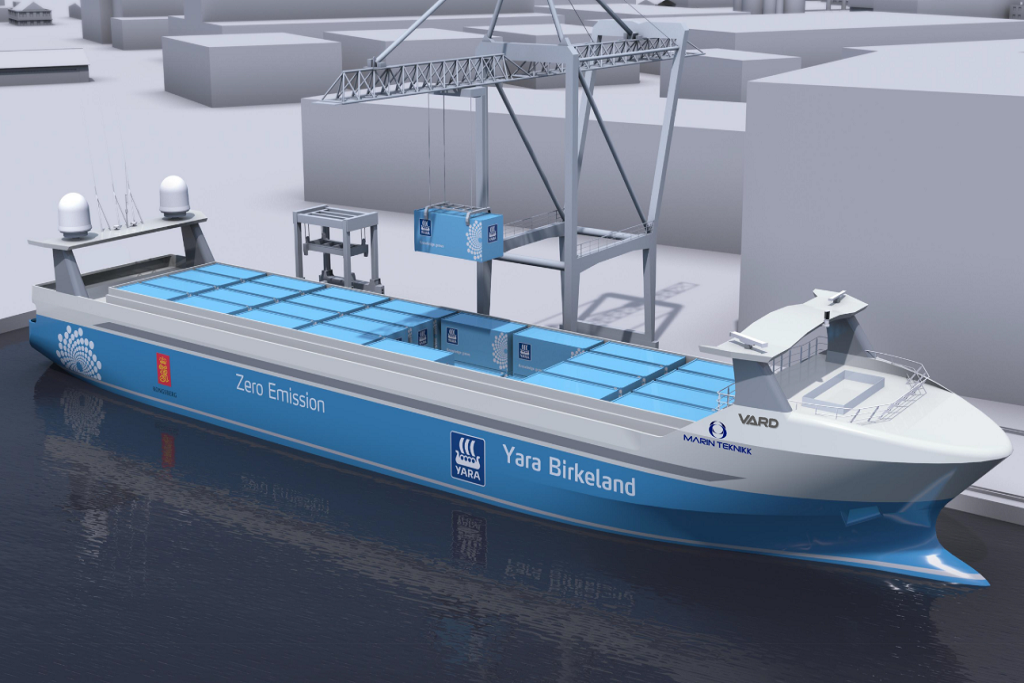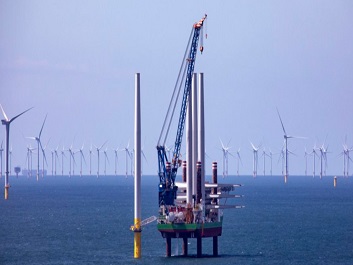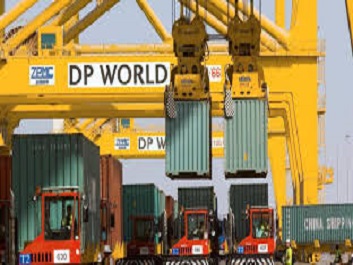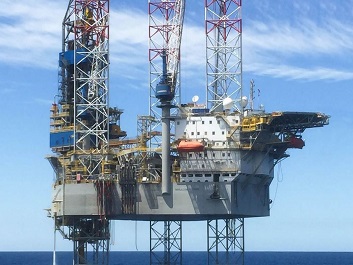Development of the world’s 1st zero emissions, autonomous feeder halted due to COVID-19
The development of the world’s first autonomous and electric container vessel Yara Birkeland has been paused due to the COVID-19 pandemic and the changed global outlook, Norwegian company Yara informed. The hull of the Yara Birkeland vessel was launched to sea at Vard Braila in Romania in February 2020 and is expected to arrive at Vard Brevik in Norway in May where she will be fitted with various control- and navigation systems and undergo testing before delivery to Yara. The vessel was scheduled for delivery in the first quarter of 2020, and from there the vessel was supposed to gradually move from manned operation to fully autonomous operation by 2022. However, due to the latest turn of events, the new delivery date is yet to be determined. The ship had been announced by Yara and technology company Kongsberg as the world’s first fully-electric container feeder, which will produce zero emissions. Under the partnership, Kongsberg is in charge of the development and delivery of all key enabling technologies on Yara Birkeland including the sensors and integration required for remote and autonomous operations, in addition to the electric drive, battery and propulsion control systems. According to its developers, the containership will be able to carry a full load of five meters deep, but only three meters in ballast. Its normal speed, which is also a determining factor for the ship’s hull shape, will be six knots while total speed will be 13 knots. Once delivered, the vessel is planned to ship products from Yara’s Porsgrunn production plant to Brevik and Larvik in Norway, helping move transport from road to sea and thereby reducing noise and dust, NOx and Co2 emissions.(Credits: www.offshore-energy.biz)

Borssele 1+2 construction team not skipping a beat

Orsted has provided an update on the ongoing offshore construction work at the 752 MW Borssele 1 + 2 offshore wind farm in the Dutch North Sea, saying that all activities are going according to plans. So far, DEME’s installation vessel Innovation has installed 73 out of the 94 monopile foundations at the site some 23 kilometres off the coast of Zeeland. The installation of the Nexans inter-array cables has reached a halfway point. Van Oord has installed 47 out of the 94 inter-array cables. Van Oord has deployed its dedicated cable-laying vessel Nexus and the trencher Dig-It to install and bury the 94 inter-array cables to a depth of 2 metres. The wind farm’s first foundation was installed mid-January and the first inter-array cable was put in place at the end of February. The installation of the wind farm’s turbines started in mid-April. So far, DEME’s jack-up Sea Challenger has installed eleven out of the 94 Siemens Gamesa 8 MW units. The wind farm delivered its first power at the end of April. Borssele 1+2 is expected to be completed by the end of 2020 when it will become the largest offshore wind farm in the Dutch North Sea.(Credits: www.offshore-energy.biz)
Valaris, offshore drilling contractor with the world’s largest fleet, has filed for bankruptcy protection in an attempt to restructure its debt. Valaris said on Wednesday that it voluntarily filed for a Chapter 11 financial restructuring in the United States Bankruptcy Court for the Southern District of Texas. According to the offshore driller, it aims to pursue an efficient restructuring process and exit Chapter 11 as soon as possible and is confident that a comprehensive financial restructuring is n the best interest of the company and its stakeholders in the long-term. It claims that it will have one of the best balance sheets in the offshore drilling industry after consummation of the contemplated restructuring transactions. Valaris further stated that it was confident of running its business normally since it has around $175 million in cash. Also, certain noteholders will provide the company with an additional $500 million of liquidity, with an option to have no cash interest, to support its operations throughout the Chapter 11 process.Credits www.offshore-energy.biz)

DP World’s H1 profit takes a massive hit

Dubai-based port and terminal operator DP World reported a profit attributable to owners of $313 million for the first half of 2020, a decrease of 58.5 % from the last year’s equivalent of $753 million. However, the company reported a revenue growth of 17.7 % on a reported basis having booked $4.07 billion in revenue for the period. Like-for-like revenue decreased by 11.6% and down 3.4% excluding Emaar land sale in 2019. DP World said the results were better than expected having in mind the relentless impact of COVID-19 on the world trade.The Covid-19 outbreak has undoubtedly resulted in one of the most challenging periods in the history of our industry. Our gross volumes have declined by 3.9% in 1H2020 which compares favourably against an estimated industry decline of 10%. However, our like-for-like EBITDA6, excluding land sale in the prior period, has grown by 1.1% during this period which demonstrates that we have managed costs efficiently,DP World Group Chairman and CEO, Sultan Ahmed Bin Sulayem, said. This outperformance once again demonstrates that we are in the right locations and a focus on origin and destination cargo will continue to deliver the right balance between growth and resilience. Moving forward, DP World believes that the outlook remains uncertain, but trade is expected to recover when economies re-open. Overall, we are encouraged that our business has performed better than expected given the Covid-19 pandemic and, while the outlook is still uncertain, we remain positive on the medium to long-term fundamentals of the industry Bin Sulayem said.(Credits: www.offshore-energy.biz)
Santos to launch Dorado FEED program in second half of 2020

Australia Santos expects to begin the front-end engineering design (FEED) program for the Dorado oil and gas project offshore Australia in the second half of 2020. Carnarvon, a partner in the project, said on Thursday that the pre-FEED competition for the supply of floating production storage and offtake vessel (FPSO) for the Dorado project was well advanced with BW Offshore, Modec, and Altera formerly Teekay. According to the company, all three recently presented technically robust proposals are capable of fulfilling the requirements of delivering 75,000 to 100,000 barrels of oil per day. An initial phase of oil and condensate production with gas reinjection will support the oil recovery on the project. To remind, Santos started the competitive process for the supply of the FPSO in mid-May. Carnarvon added that work continued on the tendering for the wellhead platform (WHP) to finalise the concept select definition for FEED to start as scheduled around the end of this quarter. The WHP is expected to host 8 to 10 wells for the Dorado production and have the capacity to accommodate production from possible future tie backs. It is worth adding that preparation of the offshore project proposal and field development plan is underway(Credits: www.offshore-energy.biz)

